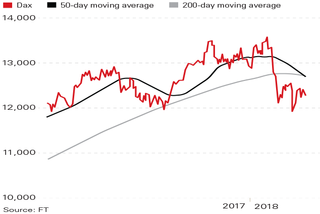Chart of the week: The Dax’s “death cross” rattles traders
Last week, Germany’s benchmark index, the Dax 30, produced a “death cross”: a widely watched technical indicator that often heralds further falls.

Last week, Germany's benchmark index, the Dax 30, produced a "death cross": a widely watched technical indicator that often heralds further falls. It occurs when the 50-day moving average of a share or index slips below the 200-day moving average.
It is apparently especially worrying when both averages are declining, as is currently the case. In the last decade there have been four death crosses in the Dax, Matthew Maley of Miller Tabak + Co told the Financial Times, "and they were all followed by significant declines".
The fundamentals aren't looking very encouraging either: Germany's heavyweight industrial and car stocks are considered to be vulnerable to further US protectionism.
Subscribe to MoneyWeek
Subscribe to MoneyWeek today and get your first six magazine issues absolutely FREE

Sign up to Money Morning
Don't miss the latest investment and personal finances news, market analysis, plus money-saving tips with our free twice-daily newsletter
Don't miss the latest investment and personal finances news, market analysis, plus money-saving tips with our free twice-daily newsletter
Viewpoint
"World markets are taking another step to embrace China. Bloomberg will add the country's [government debt and bonds issued by state-backed banks] to the Bloomberg Barclays Global Aggregate index [to] attract foreign investors and encourage more liberalisation [China's] $9trn domestic bond market is the world's third largest after the United States and Japan but most international investors have little exposure The bond index news landed one day after US president Donald Trump announced new tariffs on Chinese imports... aimed at reducing the US trade deficit with China, which hit $375bn in 2017. But money flows vastly exceed those of goods and services, with daily trading in currencies averaging more than $5trn A move that encourages more financial transactions with China offsets Trump's barriers to traditional trade."
Tom Buerkle, Breakingviews
-
 Should you invest in UK equities?
Should you invest in UK equities?The FTSE 100 hit a record high this week, but UK equities remain unloved and undervalued compared to their global and US peers. Should you snap them up at a discount?
By Katie Williams Published
-
 State pension errors: DWP urged to check for mistakes among divorced people
State pension errors: DWP urged to check for mistakes among divorced peopleFormer pensions minister Steve Webb says there are a high number of divorced women on low state pensions. Now MPs want the DWP to check if there were any errors in “potentially underpaying men and women who are divorced”.
By Ruth Emery Published